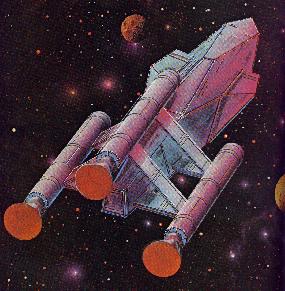Tritium Class Cruiser

USS Tritium on its test flight
Image scanned from the Star Trek Spaceflight Chronology
The Tritium class cruiser was one of the most notorious failures in the history of Starfleet Research and Development. The project was an attempt to create a tri-nacelle cruiser, with the idea that three nacelles would make the ship faster with a higher acceleration curve. The exact opposite result came about, as the three nacelles ended up creating disruptive warp field harmonics. Basically, the computers on the Tritium just were not fast enough to synchronise the three nacelles. Ironically, Zephram Cochrane had warned the Uniteed Earth Space Probe Agency about 70 years before that working with nacelles that were not in multiples of two would prove almost impossible without a very sophisticated and fast artificial intelligence to compensate for the negated harmonics. On its first trial run, the Tritium managed to get up to warp 3 before the warp field collapsed, sending the ship tumbling out of warp. Luckily, it had been launched from the Pluto test range where there was not too much around for it to hit when it went out of control. The Tritium then limped back to pluto on impulse power as the R&D engineers went back to the drawing board.
So as to not make the project a complete failure, R&D decided to find a way to make the overall design useable. They removed the upper warp nacelle, allowing the ship to function normally. Although its top speed was just as fast as the older Daedalus class cruisers, the Tritium class was brought into production, with a total of ten ships having been built, and proved to be a decent front line cruiser. The Tritium class also had the distinction of being the first ship class to use the newly invented tricorders for landing party duty.
Specifications:
- Dimensions:
- Length: 150 meters
- Width: 120.75 m
- Height: 88.95 m
- Compliment:
- Officers: 15
- Enlisted: 100
- Propulsion:
- Warp: 2 Early 3rd Generation Warp Nacelles
- Max Warp: 3.75
- Cruise: 3.25
- Sublight: 1 Fusion Thrust Impulse Drive
- Weapons:
- 6 Laser Banks (3 forward, 3 rear)
- 8 Ion Particle Accelerator Cannons (6 forward, 2 rear)
- 3 Missile Tubes (2 forward, 1 aft), 150 nuclear torpedoes
Return to history index

